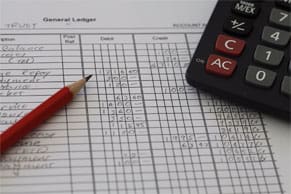Imagine trying to navigate a city without a map; managing a business’s finances can feel that way without a well-structured chart of accounts. A business’s chart of accounts is a simple list of its financial accounts that reflects the business’s financial architecture. If that architecture is effectively designed and in alignment with the finances of the business, a chart of accounts will be a key reference tool that helps make financial analyses easier to achieve.
Whether or not its leaders are familiar with financial principles, any small business ready to grow to the next level will find a chart of accounts a necessary tool.
What Is a Chart of Accounts (COA)?
At the highest level, a chart of accounts is a list of all the financial accounts on a company’s general ledger, which is the central record of all the business’s transactions within an accounting period.
A chart of accounts assigns an alphanumeric code to each account, which unlocks subsequent reporting and analysis. In this way, the chart of accounts can be a tool to help business managers run their companies effectively by helping to produce accurate and timely financial reports for owners and investors.
Key Takeaways
- A chart of accounts is a business’s list of financial accounts, reflecting the structure of the company’s balance sheet and income statement.
- Detailed charts of accounts categories are individual to the business and set by management.
- Once established, it’s best never to change a chart of accounts. But since businesses operate in the real world, it’s important to think through changes carefully when needed.
Chart of Accounts Explained
Every business should have three principal financial statements: a balance sheet, an income statement—the formal name for what many call “the P&L,” or profit and loss statement—and a cash flow statement. Only the balance sheet and income statement accounts are reflected on the chart of accounts.
Note that in this case, “accounts” are the finance equivalents of folders in computer storage, used for tracking purposes rather than literal bank accounts.
Because balance sheets and income statements are based on accounts that are all listed on it, the chart of accounts is a catalog that reflects the entirety of a business’s finances. It separates revenue, expenses, assets, liabilities, and equity into different accounts. This separate tracking gives managers a better understanding of both incoming and outgoing cash flow on a day-to-day basis.
Why Is the Chart of Accounts Important?
The chart of accounts is important because it’s the primary reference tool for a company’s financial structure. It’s the central hub for the company’s financial accounts, which are the source of its principal financial statements. A well-constructed chart of accounts allows management to obtain a birds-eye view of the company’s financial performance from its general ledger. In the same way, it also helps the company to simplify and streamline end-of-period reporting.
How Does the Chart of Accounts Affect Financial Reports?
The detail put into a chart of accounts sets the ceiling for financial analysis. If the chart of accounts doesn’t capture a data point, it won’t make it into any report. Whether reports are run manually or are software-generated, each one simply regroups the distinct transaction categories defined in the chart of accounts. For example, to analyze profitability by department, the chart of accounts structure will need specific departmental distinctions. Adding those distinctions after the fact would mean slogging through and re-coding each historical transaction.
A well-structured chart of accounts also supports accurate, compliant financial statements. Misclassified accounts can distort key metrics and trigger audits, especially for businesses following Generally Accepted Accounting Principles (GAAP). For instance, recording short-term debt as a long-term liability inflates the current ratio and masks potential liquidity problems. A clean chart of accounts helps prevent these errors to give a clear, accurate view of the business’s financial health to stakeholders such as lenders, investors, and shareholders.
How Charts of Accounts (COA) Work
Two high-level categories exist on a chart of accounts: balance sheet accounts, which record the company’s assets, debts, and net worth, and income statement accounts, which record income from all sources as well as expenditures. Balance sheet accounts feed into the company’s balance sheet, and income accounts feed into the company’s income statement.
Balance sheet accounts are subdivided into three groups: asset accounts, which record all valuable resources the company owns; liability accounts, which record all the company’s debts; and equity accounts, which represent the value left in the business after liabilities have been subtracted from assets.
Income accounts are subdivided into two groups: revenue accounts, which record the company’s income from all sources, and expense accounts, which record all the company’s expenditures.
Within each of these groups are lines representing individual account types. Each line includes a brief description of the account’s transaction type (e.g. asset or liability), the account type, and a unique code. Each line on a chart of accounts represents an account in the company’s general ledger.
What Is Included in a Chart of Accounts?
A chart of accounts includes line items for every account in a business’s general ledger, which records transaction activity related to nearly everything the company owns, everything it owes, and the equity belonging to its owners or shareholders. Thus, the chart of accounts offers a complete reference to where the company’s finances are recorded.
However, exactly what lines a company has in its chart of accounts is a management decision and depends on the nature of its business and how it is financed. For example, asset accounts might include unsold inventory for a shop, intellectual property for a design company or, for a large conglomerate, accounting goodwill from its acquisitions.
The lines in a chart of accounts can be related to each other. For example, a company that is financed principally with debt will have liability accounts for its debts and expense accounts for the interest payments related to those debts.
Categories on the Chart of Account
Most charts of accounts have five top-level categories. The first three flow into the balance sheet, and the other two flow into the income statement. The five are:
- Assets
- Liabilities
- Equity
- Revenue
- Expenses
Some, however, break out gains and losses as top-level categories instead of including gains within revenue and losses within expenses, making seven in all.
It’s often easiest to structure the subcategories in a chart of accounts broadly in the financial reports into which they feed. This strategy ensures that balance sheet accounts follow the structure of the balance sheet, and income accounts follow the structure of the income statement.
The following sections detail the specifics of how that approach works.
Balance Sheet Accounts
The balance sheet divides assets and liabilities into current and noncurrent, so it can be helpful to do this on the chart of accounts, too. The following are key definitions used in balance sheet accounts:
Asset accounts record everything the company owns.
Current assets are assets that are either cash or can be quickly and easily realized in cash terms and include:
- Cash and cash equivalents, such as bank deposit accounts
- Marketable securities, such as bonds and shares in publicly traded companies
- Inventory
- Accounts receivable
Non-current assets are assets that can’t easily be sold to obtain cash. Some of them can, however, be used as collateral for borrowing. They can include:
- Real estate, or premises
- Plant and equipment
- Intellectual property, such as patents
- Goodwill, which is the difference between the amount a company pays to acquire a company and the fair value of that company’s assets
- Investments, such as stakes in private companies or joint ventures.
Liability accounts record everything the company owes.
Current liabilities are debts that must be paid back or otherwise settled within one year. They include:
- Bank overdrafts and other debts falling due in one year or less
- Accounts payable, such as supplier invoices that have not yet been settled
- Accrued expenses, such as electricity usage that has not yet been billed by the utility company
- Prepayments
Non-current liabilities are long-term debts and other liabilities, such as leases, that don’t need to be settled within one year.
Equity accounts record the company’s net worth, which is the difference between the value of its assets and the value of its liabilities. Equity accounts can include the following:
- Common stock (issued shares)
- Treasury stock (shares that have been repurchased by the company)
- Retained earnings (last year’s profits)
- General reserve (money set aside to cover unexpected eventualities)
- Owners’ equity (the owner’s money used to fund the business)
Income Statement Accounts
Income statements are divided into categories for revenue and gains and expenses and losses. Those are the next-level categories on the chart of accounts. The following are key definitions used in income statement accounts:
Revenue accounts record the company’s income from all sources, both earned, such as from sales and fees, and unearned, such as investment gains. Negative income, such as sales returns, goes into income accounts, not expense accounts. Income accounts typically include the following:
- Sales revenue
- Sales returns
- Investment gains
Expense accounts record all the company’s expenditures, plus non-cash expenses such as depreciation and amortization. Typical expense accounts include:
- Cost of goods or services sold (COGS)
- Marketing, advertising, and promotions
- Wages
- Travel expenses
- General and administrative expenses such as rent, utility bills, insurance, and legal fees
- Depreciation and amortization
- Interest paid
- Taxes paid
Chart of Accounts Structure
The chart of accounts acts as the backbone of a company's financial reporting system. With a logical chart of accounts structure, businesses can align their financial recording processes, balance sheet accounts, and income statement accounts to create consistent and unified records across departments. The two primary chart of accounts hierarchies are account categories and numerical codes.
Account Categories
The account categories in a chart of accounts mirror the structure of financial statements. They typically begin with assets, followed by liabilities and equity (the balance sheet accounts), then revenue and expenses (the income statement accounts). Within each primary category, accountants often add subcategories to reflect the specific needs of the business. For example, assets might be divided into current and non-current, with further subdivisions for cash, accounts receivable, inventory, and fixed assets. This structure keeps relationships between accounts clear, so detailed reports are easier to generate and understand—even for stakeholders without an accounting background.
Numerical Codes
Numerical coding turns a simple list of accounts into a functional financial system. Each account is assigned a unique number that identifies its type and position within the chart. The first digit usually reflects the primary category (e.g., 1 for assets or 2 for liabilities), with subsequent digits specifying subcategories and individual accounts.
For instance, in a five-digit system, 10010 might represent “Cash in Checking,” where "1" indicates an asset, "00" specifies current assets, and "10" designates the specific account. Similarly, 10020 might designate another current asset, but with a different account number, such as accounts receivable.
This coding system enables swift account location, creates consistency when recording transactions, and supports automation in accounting software.
Setting Up the Chart of Accounts
When setting up a chart of accounts for the first time, it’s important to consider the way the business works beyond reporting for legal and tax purposes. How many business lines are there? What kinds of expenses does the business typically incur? What types of assets does it have, including intangibles?
Managers can list as many accounts in a chart of accounts as needed for a detailed view of all the financial activity within the company. It’s important to consider such potential financial analyses when establishing the chart of accounts because, ideally, once it should remain frozen after setup.
But during setup, a business can adjust the basic structure shown in the previous section to better meet management needs. For example, expenses can further divide into direct costs—expenses that directly feed into cost of production—and indirect costs. This would make it easier to calculate gross margins. It can also be helpful to relate the chart of accounts to budget categories, so managers get an at-a-glance view of business performance against expectations when reviewing the listed accounts.
When the quantity of lines and types of categories are established, the next step is to code them. Typically, the coding system on a chart of accounts is structured so that various categories of accounts can be easily identified. For example, asset accounts might all have codes beginning with A, while liability accounts might have codes beginning with L.
Here’s an example of a simple structured coding system:
| Assets | 1000-1999 |
| Liabilities | 2000-2999 |
| Equity | 3000-3999 |
| Income | 4000-4999 |
| Expenses | 5000-5999 |
Chart of Accounts Examples
Here’s what a basic chart of accounts might look like for a small manufacturing company.
| Code | Description | Type | Category |
|---|---|---|---|
| 10010 | Cash & equivalents | Asset | Balance sheet |
| 10020 | Accounts receivable | Asset | Balance sheet |
| 10030 | Inventory | Asset | Balance sheet |
| 11010 | Premises & equipment | Asset | Balance sheet |
| 20010 | Bank overdraft | Liability | Balance sheet |
| 20020 | Accounts payable | Liability | Balance sheet |
| 21010 | Bank loans | Liability | Balance sheet |
| 30010 | Owners’ equity | Equity | Balance sheet |
| 31010 | Retained earnings | Equity | Balance sheet |
| 40010 | Revenue | Income | P&L |
| 50010 | Supplies | Expense | P&L |
| 50020 | Marketing | Expense | P&L |
| 50030 | Wages | Expense | P&L |
| 51010 | Rent | Expense | P&L |
| 51030 | Utilities | Expense | P&L |
| 51020 | Other expenses | Expense | P&L |
| 52010 | Depreciation | Expense | P&L |
| 53010 | Interest | Expense | P&L |
| 54010 | Taxes | Expense | P&L |
Note the structured coding system that allows management to pull out the various components of the financial statements quickly and easily:
-
Assets all begin with “1” and, within that, current assets are grouped together beginning with “10”
-
Liabilities begin with “2” and, within that, current liabilities are grouped together beginning with “20”
-
Equity accounts begin with “3,” and there is plenty of room to add more equity types if the owners decide to sell part of their stakes
-
In this example, revenue, beginning with “4,” is not broken down, but again, there is plenty of room to add more revenue types
-
Expenses all begin with “5” and, within that, general and administrative expenses all begin with “51”
It’s easy to construct a simple balance sheet and income statement from this chart of accounts. But there’s not much detail to work with, so it might be helpful to break this format down further to give managers a clearer view of where money is coming from and where it is going. Let’s restructure this chart of accounts to present it more clearly and provide more detail for management.
| Number | Description | Type | Category |
|---|---|---|---|
| 10000 | Current assets | Asset | Balance sheet |
| 10010 | Cash | Asset | Balance sheet |
| 10020 | Accounts receivable | Asset | Balance sheet |
| 10030 | Inventory | Asset | Balance sheet |
| 11000 | Non-current assets | Asset | Balance sheet |
| 11010 | Plant & machinery | Asset | Balance sheet |
| 11020 | Office equipment | Asset | Balance sheet |
| 20000 | Current liabilities | Asset | Balance sheet |
| 20010 | Bank overdraft | Liability | Balance sheet |
| 20020 | Invoices payable | Liability | Balance sheet |
| 20030 | Salaries payable | Liability | Balance sheet |
| 20040 | Utilities payable | Liability | Balance sheet |
| 21000 | Non-current liabilities | Liability | Balance sheet |
| 21010 | 2-year bank loan | Liability | Balance sheet |
| 21020 | 5-year bank loan | Liability | Balance sheet |
| 30000 | Equity | ||
| 30010 | Owners’ equity | Equity | Balance sheet |
| 31010 | Retained earnings | Equity | Balance sheet |
| 40000 | Revenue | Income | P&L |
| 40010 | Sales – line A | Income | P&L |
| 40020 | Sales – line B | Income | P&L |
| 40030 | Service contracts | Income | P&L |
| 50000 | Cost of Goods Sold | ||
| 50010 | Raw materials | Expense | P&L |
| 50020 | Production wages | Expense | P&L |
| 51000 | Sales & marketing | Expense | P&L |
| 51010 | Advertising | Expense | P&L |
| 51020 | Commissions | Expense | P&L |
| 51030 | Travel expenses | Expense | P&L |
| 51040 | Client entertainment | Expense | P&L |
| 52000 | General & administrative expenses | Expense | P&L |
| 52010 | Rent | Expense | P&L |
| 52020 | Utilities | Expense | P&L |
| 52030 | Transport | Expense | P&L |
| 52040 | Executive remuneration | Expense | P&L |
| 52050 | Administrative staff salaries | Expense | P&L |
| 52060 | Insurance | Expense | P&L |
| 52070 | Audit fees | Expense | P&L |
| 52080 | Bank fees | Expense | P&L |
| 52010 | Depreciation | Expense | P&L |
| 53010 | Interest | Expense | P&L |
| 54010 | Taxes | Expense | P&L |
This two-level chart of accounts has much more detail than the first example, yet it’s easier to read. The granularity in the income and expense accounts could give management a clearer picture of where money is coming from and where it’s going. And, this chart can still be used to produce the all-important balance sheet and income statement.
Common Chart of Accounts Challenges
A chart of accounts doesn’t usually change often, but that doesn’t mean it stays problem-free. Over time, issues can creep in—especially as the business grows or teams evolve. Without clear structure and oversight, even a well-built chart of accounts can become cluttered, inconsistent, or hard to use. Here are some of the most common problems businesses face:
- Overcomplication: A chart of accounts can become unnecessarily complex if it contains too many categories and subcategories. This slows down data entry, increases the risk of errors, and makes reports harder to generate and harder to understand—especially for non-accountants.
- Lack of standardization: Inconsistent naming and coding can cause staff to interpret accounts in different, unintended ways. This inconsistency creates reconciliation problems, reporting gaps, and trouble rolling up results across departments or entities.
- Duplicate categories: Without clear rules, people may create new accounts instead of using existing ones. Over time, this splits transactions across multiple lines, making it harder to compare results over time or get a clear view of actual costs and revenues.
- Misalignment with financial reports: If the chart of accounts doesn’t follow required reporting standards or match reporting needs, the resulting report can be messy or delayed—which can also lead to compliance issues. Fixing it later usually means making manual adjustments, adding time and increasing the risk of errors.
Chart of Accounts Best Practices
Over the years, accounting managers have developed a handful of practices that serve most companies well in developing their first charts of accounts.
Use a Basic Structure That Is Aligned to the Business’s Financial Reporting Needs
Keep your balance sheet and income accounts separate, but make sure they relate to each other where necessary. For example, if the company has debts, make sure the chart of accounts has both debt liability accounts and interest expense accounts.
Organize the Chart of Accounts to Support Management Decision-Making
Define the business’s account types based on how the business works. Make sure the chart of accounts gives a clear picture of where money is coming from and where it’s going. Align the chart with budget categories so the business’s performance against expectations can be seen at a glance.
Use Structured Codes and Subheadings to Help Pull Out Key Information Quickly and Easily
A five-digit structured code can give enough granularity for two or three levels in a chart of accounts. Leave enough room in the coding scheme to add lines when needed.
Make Use of Modern Accounting Software
Note that cloud-based accounting software can add dimensionality within transaction details to stand in for additional levels on a chart of accounts, easing the burden of a complex coding scheme.
Don’t Overdo the Details
Too many layers of details can lead to a density that obscures ease of understanding. If a chart of accounts has more than three levels, consider setting up subledgers.
Change Your Chart of Accounts Only at Period-Ends
Organizations should minimize changes as much as possible. However, if changes are necessary, they should only execute at the end of an accounting period to avoid corrupting records.
How to Adjust a Chart of Accounts
While businesses should never changing their charts of accounts, they also must operate in the real world. When necessary, you can add lines to a chart of accounts, provided you have enough room in your coding scheme, but you will most likely have to make manual adjustments of journal entries to move the balance from existing lines to the new ones. Here’s how to do that.
Suppose that in the more detailed chart of accounts example above, the small manufacturing company is selling far more service contracts this year than it has historically. In fact, it’s selling a service contract along with almost all of its goods. But the service contracts have different prices depending on the product sold. Thus, management wants to break down line 40030, Service Contracts (income) into two lines: Service Contract Line A and Service Contract Line B.
This requires two new lines that then apportion the existing balance from 40030 between them:
-
Create New Lines in the Chart of Accounts
Because the change is happening halfway through the accounting period, the existing line 40030 can’t be deleted. Numbering the new lines like this keeps the old and new lines together as a group:
-
40031 Service Contract Line A
-
40032 Service Contract Line B
-
-
Apportion the Balance
Let’s suppose that at the time of the change, the balance on line 40030 is $300,000. Invoice receipts show $200,000 of that came from service contracts for Line A and the remainder from contracts for Line B. So we need to make the following journal entries:
| COA Line | Debit | Credit |
|---|---|---|
| 40030 Service Contracts | $300,000 | |
| 40031 Service Contracts Line A | $200,000 | |
| 40032 Service Contracts Line B | $100,000 |
Automate and Manage Your Chart of Accounts With Accounting Software
Once a business decides how to organize its chart of accounts, it can be set up on accounting software that populates the resulting accounts automatically from invoices and receipts, so managers won’t have to manually reconcile a paper trail back to the appropriate account. Modern accounting software enables journal entries on demand manage your chart of accounts to meet the business’s changing needs. And accounting software can produce powerful and timely reports for management and statutory purposes.
If you aren’t confident about setting up a chart of accounts from scratch, some accounting software provides templates that can be adapted to meet your business’ needs. If the business has an existing paper-based chart of accounts, migrating it to cloud-based accounting software (at a period end, of course) can save time, reduce errors and improve business control. Further, NetSuite’s cloud-based financial management software can add dimensions to transaction data at any time, simplifying a chart of accounts’ coding scheme.
The chart of accounts is the accounting hub around which a business’s finances revolve. A well-organized chart of accounts is a blueprint for a powerful accounting system that can help a business manage more effectively on a day-to-day basis, as well as product management and statutory reports—especially when used in combination with a comprehensive accounting software package.
Chart of Accounts FAQ
What is the standard chart of accounts?
The standard chart of accounts lists the accounts that record everything a company owns, earns, and spends. It also lists the accounts that record the company’s net worth, which is the difference between what it owns and what it owes. A standard chart of accounts is divided into two sections: the balance sheet section and the income statement section. These feed, respectively, into the balance sheet and the income statement, which are the company’s two most important financial statements.
Is a chart of accounts similar to a balance sheet?
The chart of accounts isn’t a balance sheet, but it includes all of the elements that business managers need to create a company’s balance sheet.
What are the five types of accounts?
The five types of accounts in a chart of accounts are:
- Assets: Everything the company owns
- Liabilities: Everything the company owes
- Equity: The company’s net worth
- Income: Everything the company receives
- Expenses: Everything the company pays








